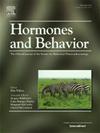一种催产素受体基因多态性与雄性草原田鼠交配时不同的神经反应有关
IF 2.5
3区 医学
Q2 BEHAVIORAL SCIENCES
引用次数: 0
摘要
催产素是一种保守的神经肽,在不同物种中调节社会和生殖行为。编码催产素受体(Oxtr)的基因Oxtr的遗传变异与啮齿动物和人类社会依恋行为的变异有关;然而,目前尚不清楚Oxtr的遗传变异如何在社会环境中塑造特定神经系统的功能。在这里,我们使用社会一夫一妻制草原田鼠(Microtus ochrogaster)来解决这个问题,草原田鼠表达一系列依赖Oxtr的社会行为,并具有Oxtr基因多态性,可以预测大脑区域特异性Oxtr表达的个体差异。我们测试了Oxtr基因多态性的神经和行为影响,该基因多态性先前与雄性草原田鼠大脑区域特异性Oxtr表达和社会依恋行为有关。我们的研究结果表明,在短暂的交配中,Oxtr基因型与交配行为的差异或大脑区域内活性依赖的即时早期基因产物FOS的表达水平无关,但它与大脑区域间相关FOS表达模式的差异有关。本文章由计算机程序翻译,如有差异,请以英文原文为准。
An oxytocin receptor gene polymorphism is associated with distinct neural responses to mating encounters in male prairie voles
Oxytocin is a conserved neuropeptide that regulates social and reproductive behaviors in diverse species. Genetic variation in Oxtr, the gene encoding the oxytocin receptor (OXTR), is associated with variation in social attachment behaviors in rodents and humans; however, it is unclear how genetic variation in Oxtr shapes the function of specific neural systems during social contexts. Here we address this question using the socially monogamous prairie vole (Microtus ochrogaster), a species that expresses an array of OXTR-dependent social behaviors and possesses Oxtr gene polymorphisms that predict individual variation in brain region-specific OXTR expression. We test the neural and behavioral effects of an Oxtr gene polymorphism that has previously been associated with brain region-specific OXTR expression and social attachment behaviors in male prairie voles. Our results suggest that, during brief mating encounters, Oxtr genotype is not associated with differences in mating behavior or in expression levels of the activity-dependent immediate early gene product FOS within brain regions, but it is associated with differences in correlated FOS expression patterns across brain regions.
求助全文
通过发布文献求助,成功后即可免费获取论文全文。
去求助
来源期刊

Hormones and Behavior
医学-行为科学
CiteScore
6.70
自引率
8.60%
发文量
139
审稿时长
91 days
期刊介绍:
Hormones and Behavior publishes original research articles, reviews and special issues concerning hormone-brain-behavior relationships, broadly defined. The journal''s scope ranges from laboratory and field studies concerning neuroendocrine as well as endocrine mechanisms controlling the development or adult expression of behavior to studies concerning the environmental control and evolutionary significance of hormone-behavior relationships. The journal welcomes studies conducted on species ranging from invertebrates to mammals, including humans.
 求助内容:
求助内容: 应助结果提醒方式:
应助结果提醒方式:


